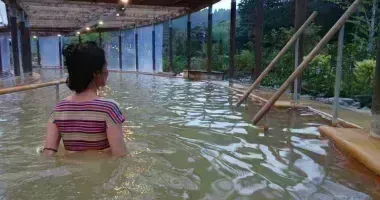Kannawa Onsen Beppu
- Published on : 27/12/2012
- by : Japan Experience
- Youtube
Kannawa: Hot Steam Magic Wonderland 鉄輪
Johannes Schonherr
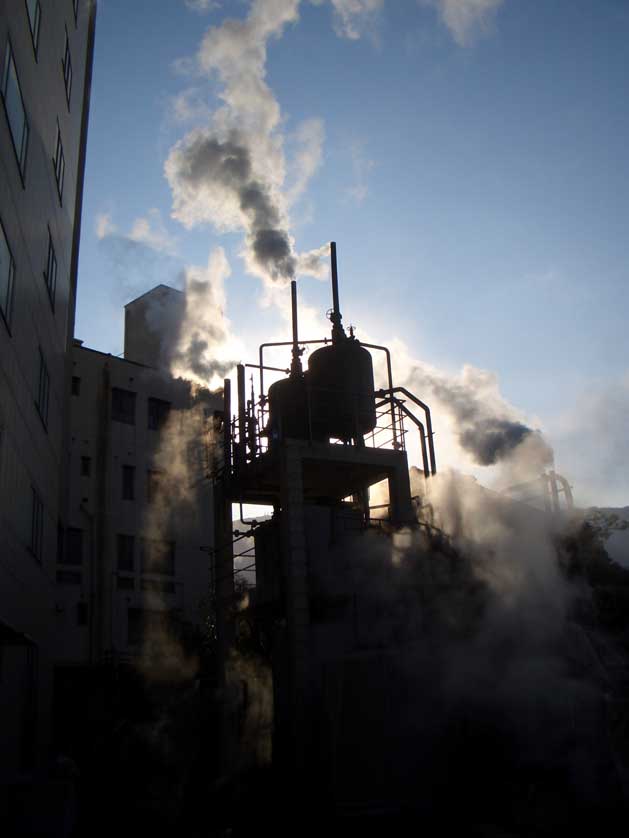
The city of Beppu in Kyushu is famous for its hot springs. There are eight different hot spring areas within the city, but Kannawa is the one directly built on a large swath of steaming ground, the steam rising everywhere and permeating everything.
Stepping out the ryokan door into the foggy maze of steam-filled Kannawa alleyways on an early rainy morning feels like stepping right into a ghost story.
Thick steam wafting out from the drains set in the pavement, concealing streams of hot water, steam jetting out of the strange salt-encrusted concrete & metal contraptions set up to handle the boiling from the underground.
The alleys are old and intersections have names like Jigokubaru (Hell Meadow). Tiny corner shops display eggs and sweet potatoes steamed in hot spring steam on their wooden racks outside. Buy some. The adding up of the charges is still done by abacus by the old ladies in the stores.
Walk up the mysterious alleys to the road (Route 218) connecting Kannawa with the sea-side area of Kamegawa and bisecting Kannawa into an upper and lower part.
The walk features a long stretch providing an unobstructed view over the whole lower section of Kannawa with its countless chimney-like pipes spewing out hot steam. It's a great panorama set against the sea and the Takasaki Mountain in the far distance and quiet spots to enjoy your hot steamed meal are a plenty. You won't find another place in the world like this.
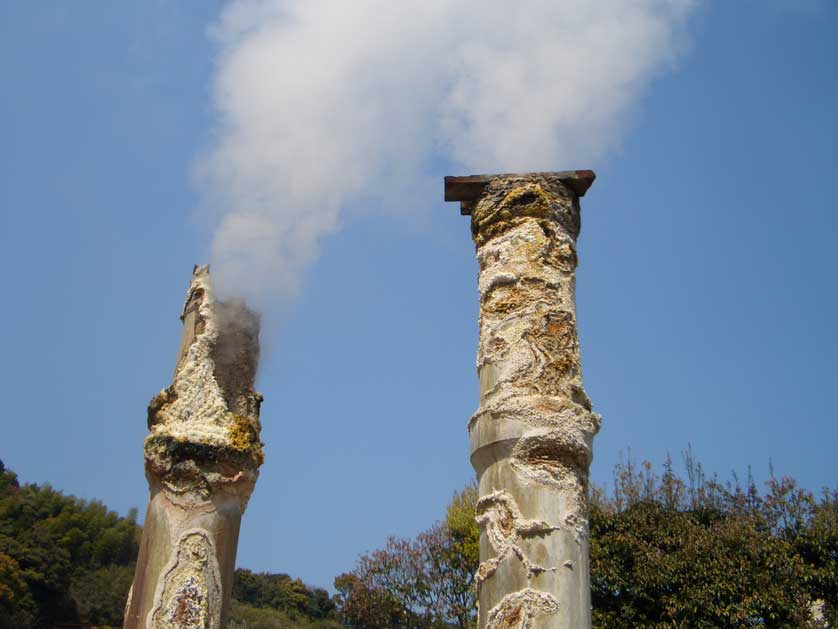
Onsen steam, Kannawa Beppu, Oita Prefecture
Arrival
On most days, you can see Kannawa already clearly from the train when arriving in Beppu. It is the area with the incredible concentration of steam clouds. From far away, it actually looks more like a giant factory from the industrial age - when chimneys were arranged as dense forests and spewed out heavy smoke unfiltered and unchecked. Fear not, though, the Kannawa steam is supposed to be very good for your health.
From Beppu Station, many bus lines will take you to the Kannawa Central Bus Stop. Arrive here, walk and explore. You will soon discover that the upper part of Kannawa is the touristy part. That's were six of the eight of Beppu's jigoku are located (the other two are in the Shibaseki part of town). The jigoku (hells) are open pools of boiling hot spring water, all of different colors and different smells. To provide additional entertainment, most of them are used to heat up enclosures for tropical animals and greenhouses for exotic plants. Up here you also find the Beppu Sex Museum.
The lower part of Kannawa, however, the part you find when you walk down Ideyu Slope from the bus station is the one breathing both history and hot steam wherever you go.
Walk down the slope and check the temple on the left. Most of the time it is closed because of problems with the many cats in the area, according to the main monk. If you are very lucky and it is open, definitely visit it. The gory drawings on the walls illustrating old Japanese sagas are amazing.
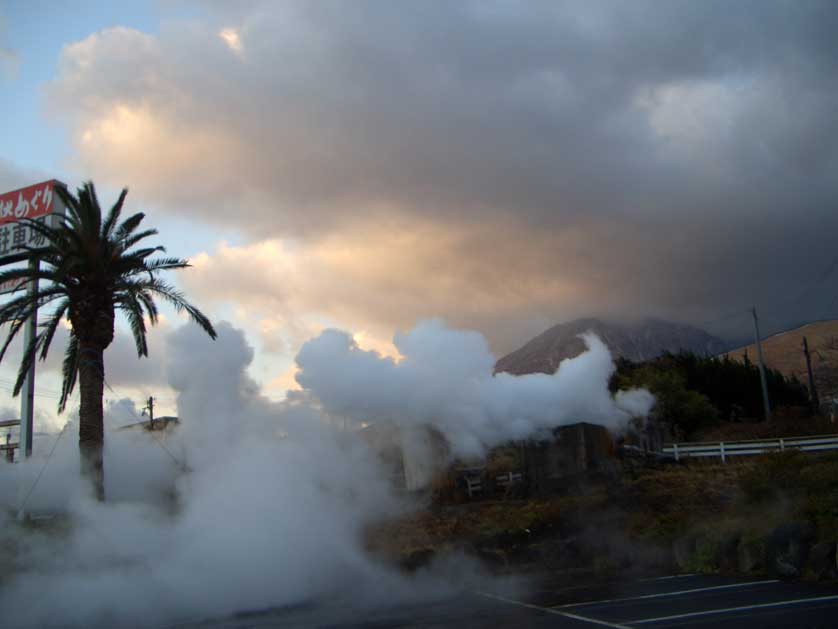
Onsen steam rises above the palm trees, Kannawa Beppu, Oita Prefecture
Ippen Shonin & The History Of Kannawa
More importantly, however, this temple was founded by and is dedicated to Ippen Shonin, the monk from Kyoto who turned Kannawa, and by extension the whole of Beppu, from an infernal volcanic wasteland into a thriving hot spring town.
Imagine an area of treacherous grounds, every wrong step could send you sinking into a pit of steaming hot sand, steam suddenly rising from the ground while boiling your body. Shonin arrived in 1276 A.D. and he knew how to turn the place around. Sink stones, along with Buddhist scripture (of course), into the ground to stabilize it, channel the flow of the hot water and put it to use. Once tamed, the hot springs would be of great benefit for the inhabitants and their guests.
You can find a new statue of Ippen Shonin in front of the Kannawa mushiyu (Kannawa Steam Bath) in the center of lower Kannawa. You are invited to pour hot water over the statue - pouring it over the body parts where you yourself have some ache is said to provide a relief.
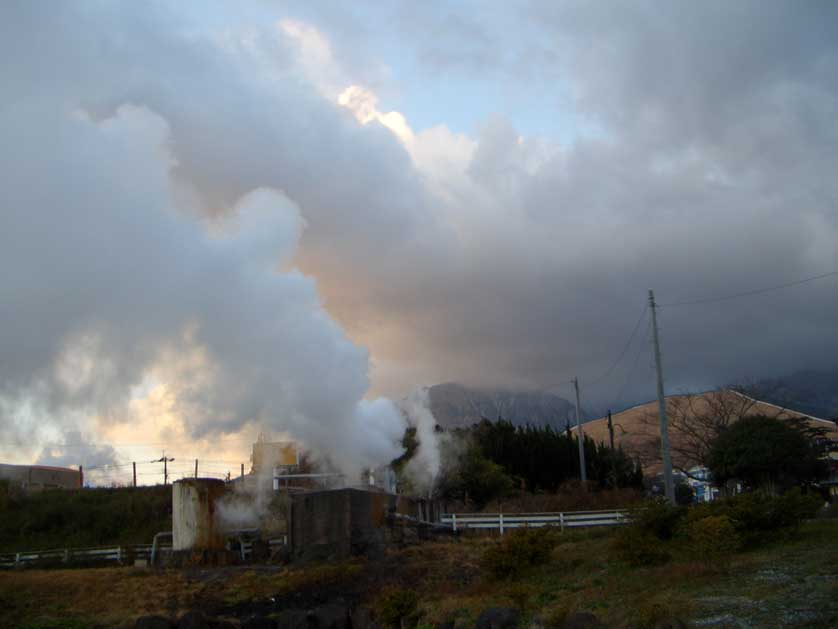
Onsen steam rises into the air, Kannawa Beppu, Oita Prefecture
Effects Of The Steam
The Kannawa Mushiyu offers, besides good bathing facilities, a really amusing and informative map of the whole area. Make sure to pick one up. It's free, though available only in Japanese. At many street corners you see larger versions of the same map posted on notice boards and they also feature English translations. You can't take those but they might help you navigate the area nonetheless.
Right behind the Mushiyu is the Fujiya Gallery. Actually, the building now housing the gallery was originally a ryokan, erected about 100 years ago. It was painstakingly restored to its former glory a few years ago and it is by far the most beautiful building in all of Kannawa. According to old photos, about a 100 years ago, most of the buildings of Kannawa looked like that single old structure.
But the past is the past and the hot steam keeps the area changing. Even the strongest hot spring water pipes made of special metal alloys can't withstand the corrosive effects of the minerals. Everything built here is subject to fast deterioration. Mechanical and electrical appliances more so than anything else.
Park your car for a long period of time on any of the steam filled lots here and you can drive it straight to the junkyard. Washing machines, air conditioners, TVs? They will all develop a life of their own. Sometimes working, sometimes stalling, depending on how the hot steam minerals accumulating in their innards and the general humidity of the air have them react. TVs might suddenly change channels or might even switch themselves on from the standby position. It's not any ghosts' work though it surely feels like it. It's simply the air here - the mineral-laden hot spring air.
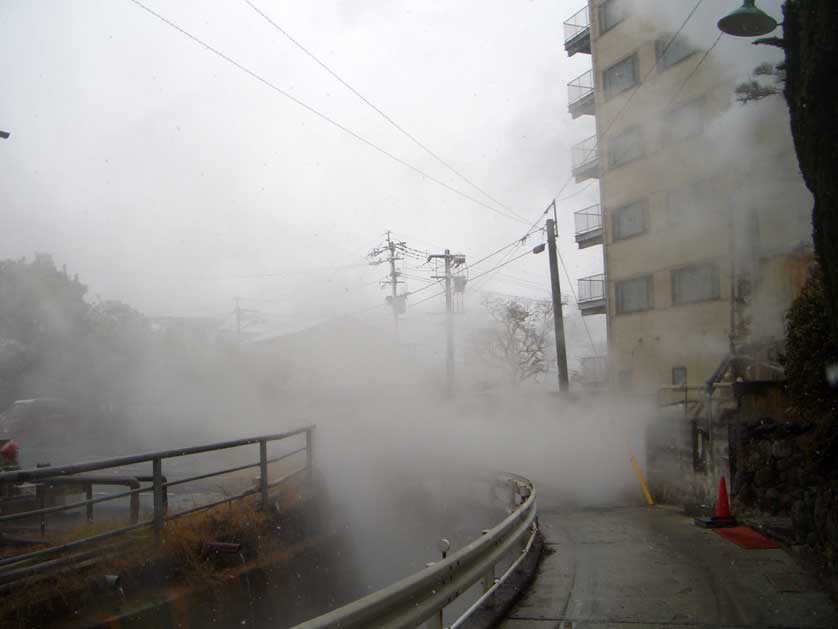
The steamy streets of Kannawa Beppu, Oita Prefecture
Kannawa Specialties
As bad as the hot steam is for the appliances, it's great for cooking. Jigokumushi is the traditional way of preparing foods here. Dishes steamed right in the hot spring vapors.
Roadside vendors operate their hot steam cooking spots and hawk onsen-steam hard-boiled eggs and sweet potatoes. A small shop in a side street offers the perhaps best butaman pork dumplings in all of Japan - steamed on hot spring steam, of course. Absolutely delicious. Ask any local for the butamanya - they will happily point you towards the little shop.
But you can cook with the hot steam by yourself just as well. Many ryokan in the area offer jigokumushi cooking spots for free use by their guests. But even if you don't stay at a local ryokan, you have the chance to try your hand at hot steam cooking. A great place for that is the Daikokuya Ryokan where you can easily reserve time at the cookers, bring your own food (vegetables, eggs and seafood are perfect), steam it and enjoy your meal with friends at the tables under the trees of the ryokan's nice little garden.
Filled your stomach? Now is time to take a soak one of the hot springs.
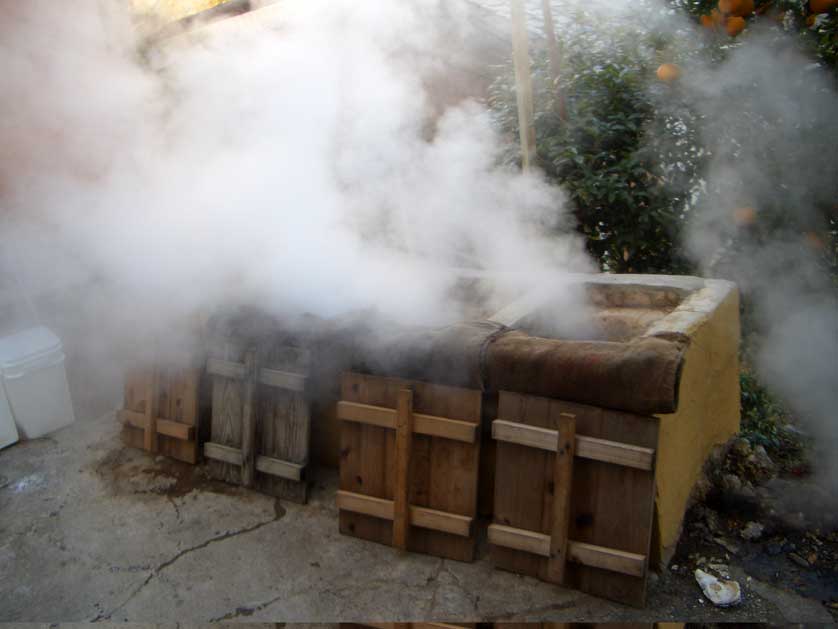
Hot steam ovens for cooking in Kannawa Beppu, Oita Prefecture
Hot Springs
The most famous hot spring bath in the area is the Hyotan Onsen. Besides various large pools segregated by gender, they also have a number of kazoku onsen (family baths) where you can enjoy the hot water privately with your partner, friends or family.
Several ryokan offer the same on a smaller scale to the public as well, meaning that you don't have to stay at the ryokan to enjoy the bath. Just ask if it is available, pay a fee of about 500 yen and enjoy the water together and undisturbed. The Miyukiya is a good example for such an easily accessible ryokan bath.
On the other hand, there a lots and lots of cheap public baths all over the area. Just look for places with a big ゆ over the entrance - that means bath (pronounced yu). Public baths, however, always have separate facilities for men and women.
Ready for another walk? Try some little alleys and find your way behind the Fugetsu Hammond Hotel (Tel: 0977 66 4141) to the Hyotan Onsen. No other place has more hot steam than this. First, there is the huge steam pipe structure feeding the baths at the hotel. It's giant. When the steam is strong you can hardly make out the large brownish hotel block behind it. In fact, staying at the hotel with a room towards this side must be a very special experience - hot steam will blow in your window all day and night.
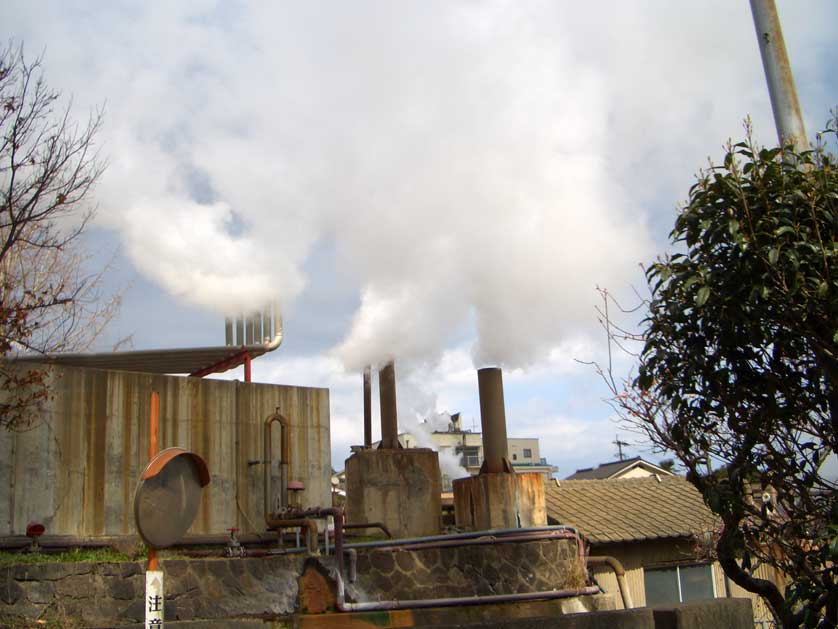
Onsen steam chimneys, Kannawa Beppu, Oita Prefecture
On the ground, a hot water river fed by the hells uphill and endless tributary boiling springs along the way flows through the area. Next to the river you can see the Bamboo Onsen Water Cooler - a high wooden rack loaded with bamboo twigs. 100 Celsius degree hot water flows over the twigs to cool it down to about 40° C - then it goes straight through a pipe to the Hyotan Onsen for public consumption. Much steam arises in the process.
Walk the little footpath to the back exit of the Hyotan - lots of pipes, steam, steam, steam and more steam shooting out at every corner.
How much steam there will be depends a lot on the time of the year and the weather conditions, though. The steam is the strongest in rainy or cold weather - when either the air is already saturated with humidity or when the hot steam contrasts with cold conditions. On dry warm autumn days, on the other hand, you will see very little of the precious grey clouds - they will disappear into the air without leaving much of a presence. My tip here: visit during the rainy season. Definitely the best time for the true Kannawa experience.
At night, Kannawa shuts down early. After 9pm, buses to downtown Beppu become rare. The few restaurants don't last much longer than the bus lines. It's quiet at night save for the hissing of the hot steam. Buy a beer at one of the two convenience stores next to the central bus stop and find that view spot again on the road to Kamegawa. Now, all the Kannawa steam is illuminated by light beams in different colors. It's an incredible sight. You thought you saw lots of steam today? See it illuminated!
The streets and alleys are absolutely empty at night. But they make for a last wonderful stroll through the steam under the yellow street lights... it's perhaps the most romantic walk you never even dreamed of.
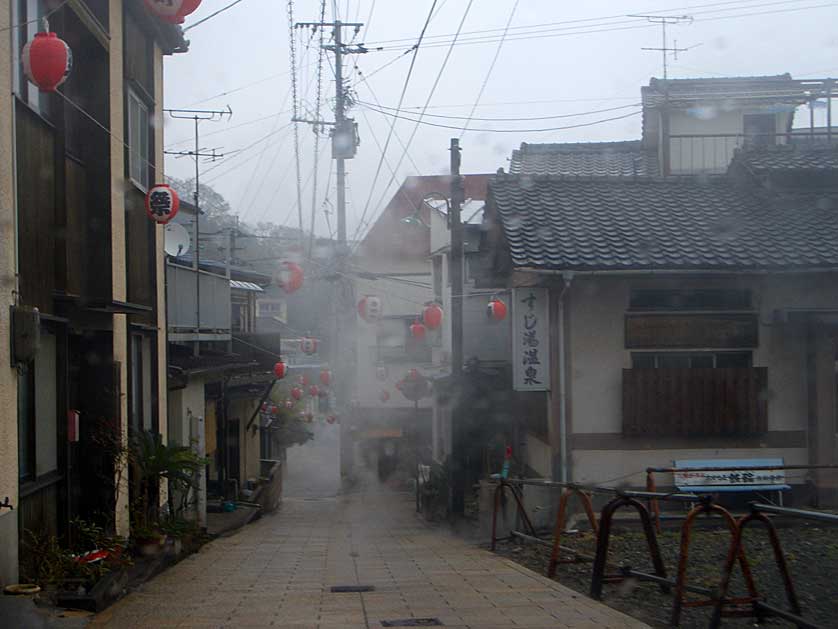
Kannawa Onsen Beppu, Oita Prefecture
Access - getting to Kannawa
Kannawa is about 25 minutes by bus from Beppu Station. Both the Kamenoi and the Oita Kotsu bus companies operate several lines to Kannawa.
Accommodation
Kannawa has plenty of big hotels along the Kyushu Odan Doro (Cross Kyushu Highway) and in upper Kannawa. There are lots of traditional Japanese ryokan in lower Kannawa, with prices starting at about 3,000 yen per person per night.
Staying at a small ryokan will give you the true Kannawa experience - but be prepared to negotiate your stay in (basic) Japanese.
Kannawa Onsen
The Hyotan Onsen has an English language website with a map giving a good first overview of Kannawa.
Kannawa Mushiyu English website
The Miyukiya Onsen Ryokan is right at the Jigokubara bus stop.
Tel: 0977 66 0360 (in Japanese only)
Preparing Jigokumushi food by yourself:
Daikokuya Ryokan, Tel: 0977 66 2301 (in Japanese only), website in Japanese
Books on Japan
Kannawa Onsen: read a guide to the area of Kannawa Onsen in Beppu, home to huge clouds of billowing steam and many hot springs.
